I’m sure you have seen adorable kittens and squeezable puppies, but what about birds? Some birds are so tiny they can fit in a teacup; others are chubby and precious as they hop along a branch. You can find dainty, lovely birds all over the planet, from owls and penguins to hummingbirds and songbirds. Meet the 12 cutest birds in the world, discover where they live, and why they will melt your heart!
Bee Hummingbird
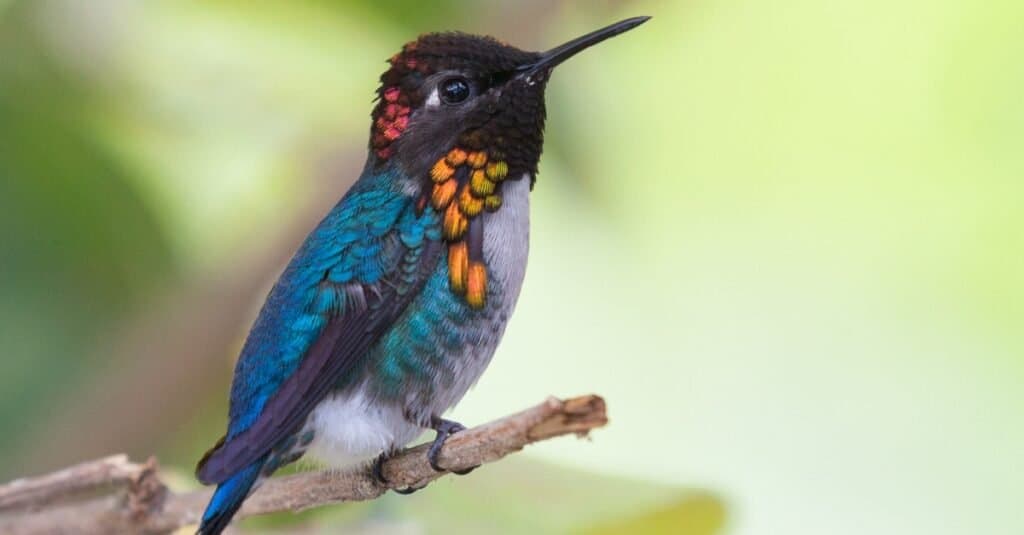
Bee
hummingbirds are thought to have the 2nd fastest heartbeat of all animals in the world.
©iStock.com/epantha
Measuring two inches and weighing 0.06 ounces, the bee hummingbird is the world’s smallest bird! This teeny tiny species is round and plump and features iridescent plumage in bright blue and green colors. And males have reddish-pink heads during the breeding season. Females are slightly bigger (not by much), and their eggs are the size of coffee beans. They have long skinny bills, which they use to dip into flowers and feed from the nectar, and they play an important role in pollination, similar to a bee. The bee hummingbird is native to Cuba and the Caribbean, where they live in dense coastal forests and forest edges.
Atlantic Puffin

The Atlantic puffin, or common puffin, is a black and white seabird with a huge multicolored bill. It spends its days bobbing along the sea, using its stout body to stay afloat. While its wings are relatively short, they produce fast wingbeats. They can quickly transition from flying to swimming, using their wings as paddles. It also uses them as propellers for diving underwater and searching for fish and crabs. You will find them in the northern hemisphere from Canada to Russia, where they nest in burrows on rocky islands. Outside of the breeding season, they live their lives at sea.
Northern Saw-Whet Owl
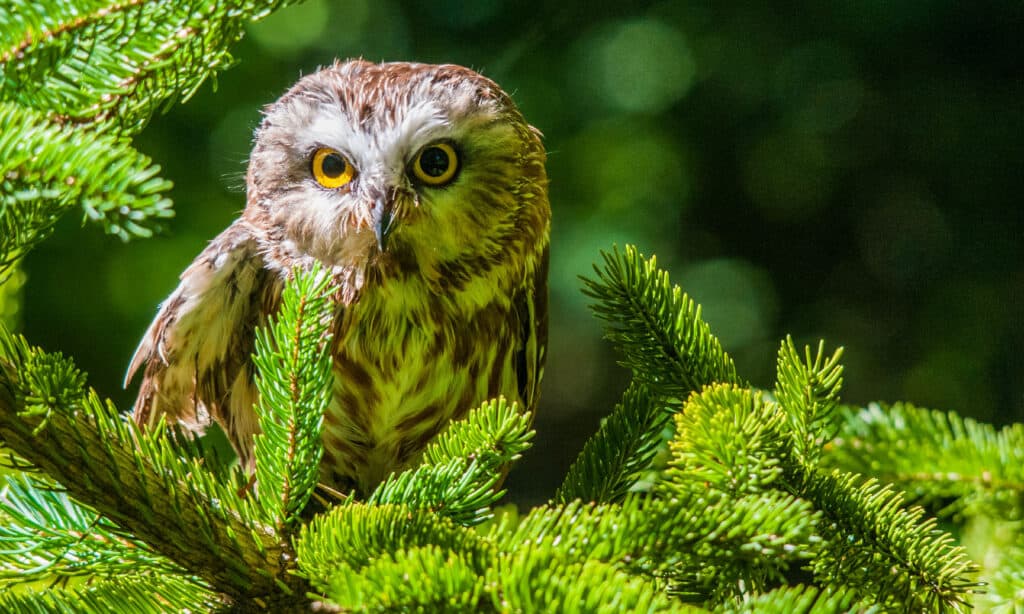
Northern saw-whets are similar in size to the
American robin
, and their precious faces are cat-like, with giant round yellow eyes.
©iStock.com/bookguy
Northern saw-whets are the tiniest owl species in North America, measuring six inches long and weighing only a few ounces. They are similar in size to the American robin, and their precious faces are cat-like, with giant round yellow eyes. However, to small mammals, these birds are fierce and hungry. They live year-round in southern Canada and the western United States and winter across the rest of America. Their preferred habitats include mature forests with open understories. But they may nest in many areas like coastal scrub, savannas, and poplar plantations.
Peach-Faced Lovebird
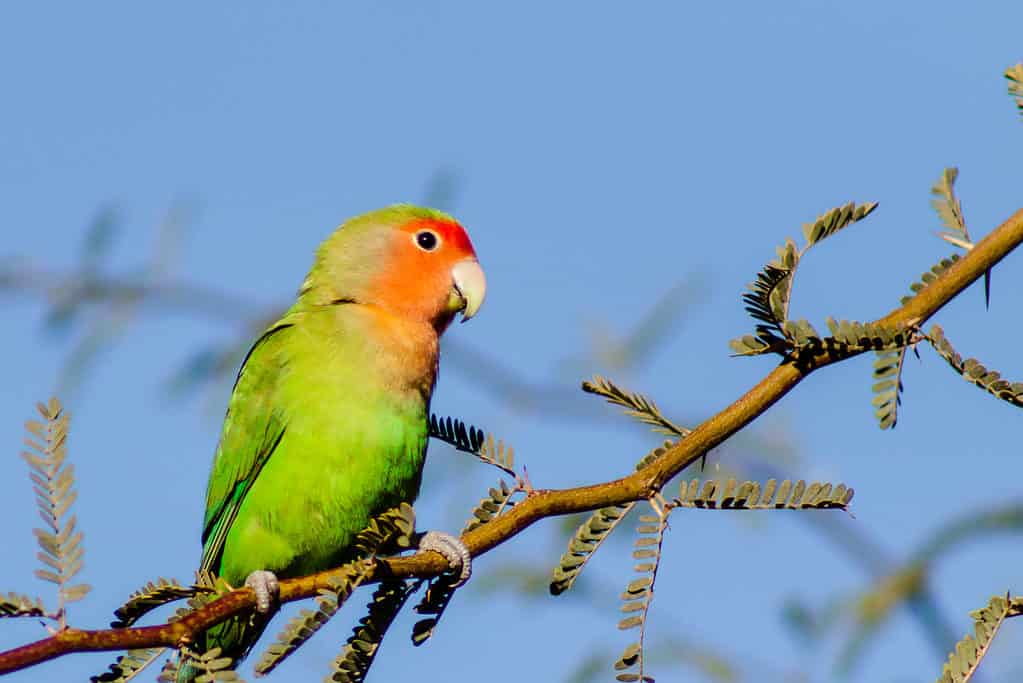
Peach-faced lovebirds live in dry, open habitats in southwest
Africa
, including Angola, Namibia, and South Africa.
©South O Boy/Shutterstock.com
Peach-faced lovebirds, also known as rosy-faced lovebirds, are colorful Old World parrots. This species is relatively small and features green bodies, blue rumps, and pink throats and faces. Males and females look similar and are known for being affectionate with each other. They are also social birds, often seen perching in trees huddled close together. They live in dry, open habitats in southwest Africa, including Angola, Namibia, and South Africa. This species is a popular captive bird in America, and many of them escape and breed in the wild. There is a feral lovebird population in Phoenix, Arizona, and they inhabit urban and rural environments.
Amazonian Royal Flycatcher

Amazonian
flycatchers
are best known for their bright royal-looking crests, primarily used during mating season.
©Tiny Turkey/Shutterstock.com
The Amazonian royal flycatcher is a beautiful and unusual-looking passerine bird found in the Amazon Basin. These birds have elaborate fan-shaped crests atop their heads in bright orange and red, making them look like true South American royalty. Despite their loud appearance, this species is a relatively quiet bird, only making slow descending whistles. They inhabit humid lowland forests along streams in Bolivia, Peru, Ecuador, Colombia, Venezuela, Brazil, and the Guianas.
Mountain Bluebird
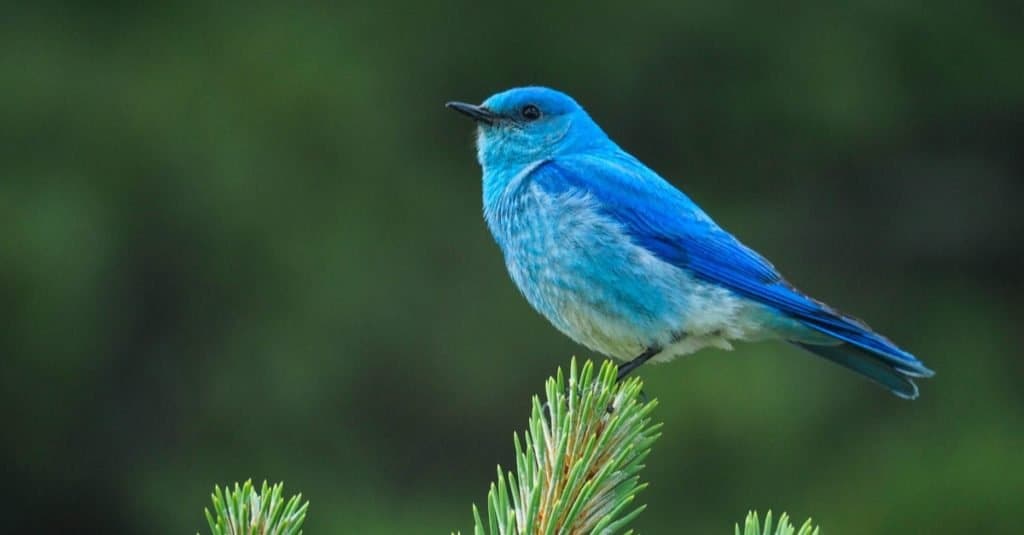
The
mountain bluebird
is a medium-sized bird weighing about 30 g with a length of 16–20 cm. They have light underbellies and black eyes.
©MTKhaled mahmud/Shutterstock.com
This small migratory thrush is a familiar sight in western North America, where they live in mountain environments like grasslands and sagebrush. They breed in Alaska, western Canada, and the northwestern United States, and winter in the Southwest and Mexico. These chunky sky-blue birds spend their days flocking in large groups to forage, hovering over berry bushes. You can often find them perched on fence posts and tree branches in the open country. Mountain bluebirds are also not afraid of humans. And females, in particular, will allow you to approach without flying away.
Goldcrest

Goldcrests
are primarily insectivores, preying on springtails and aphids.
©Catleesi/Shutterstock.com
The goldcrest is a tiny passerine from the kinglet family and the smallest bird in Britain, measuring three inches long and weighing 0.1 ounces. They get their name from their golden crest feathers and are often called the “king of the birds.” This species is widespread across Europe and northwest Asia, where they inhabit mature lowland and mountainous coniferous woodlands. They are primarily insectivores, preying on springtails and aphids. But they also consume spiders and their cocoons and eggs. They are strong fliers despite their tiny size and travel long distances during migration.
European Robin
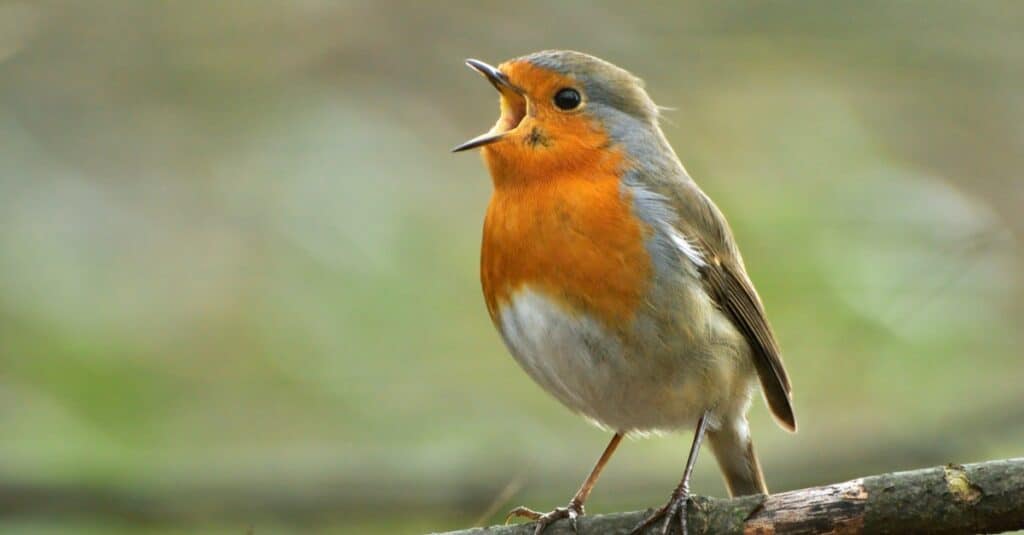
European robins
are unafraid of humans, often approaching to look for earthworms while fresh soil is turned up.
©iStock.com/Wouter_Marck
European robins are another tiny passerine native to Britain. They breed across Eurasia and winter in the northern tip of Africa. This species lives in parks, gardens, and woodlands and are well-known to gardeners in Ireland and Britain. They are unafraid of humans, often approaching to look for earthworms while fresh soil is turned up. European robins also follow after large animals, like wild boars, to look for food in loosened soil. Listen to their fluting songs all year and look for their orange breasts and bluish-grey necks. They may be one of the cutest birds in the world, but males can be highly aggressive and territorial to intruders and competing males.
Tropical Parula
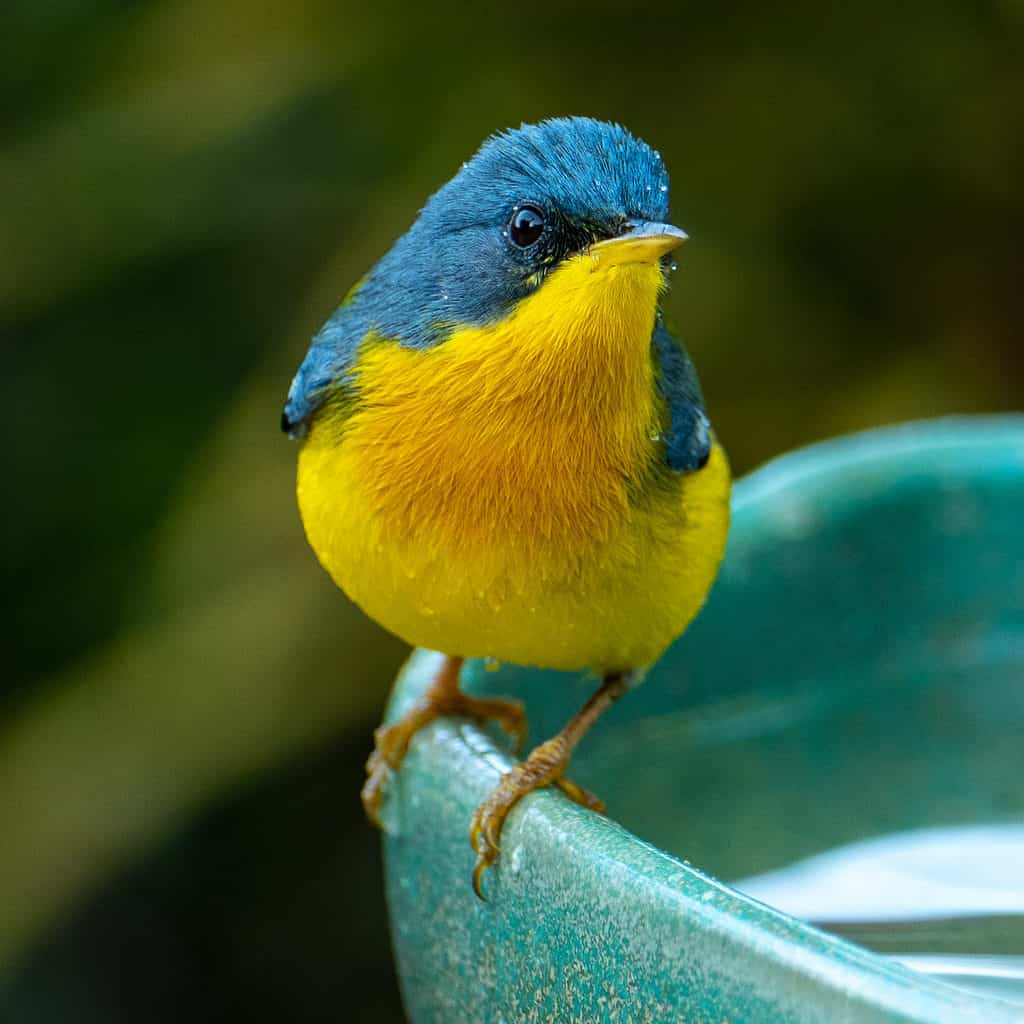
On average, tropical parulas measure four inches long and feature blue-gray upper parts and yellow underparts.
©Afonso Farias/Shutterstock.com
The tropical parula is a small warbler that primarily lives year-round in South America. However, it has a small breeding range in southern Texas and northwest Mexico. Their preferred habitats include hills and second-growth forests; they adapt well to human interruption and can thrive in disturbed forests suffering from habitat fragmentation. On average, tropical parulas measure four inches long and feature blue-gray upper parts and yellow underparts. They also have green back patches and white wingbars. These birds look round and plump as they perch on branches and posts, singing a high buzzy trill.
Ruby-Crowned Kinglet
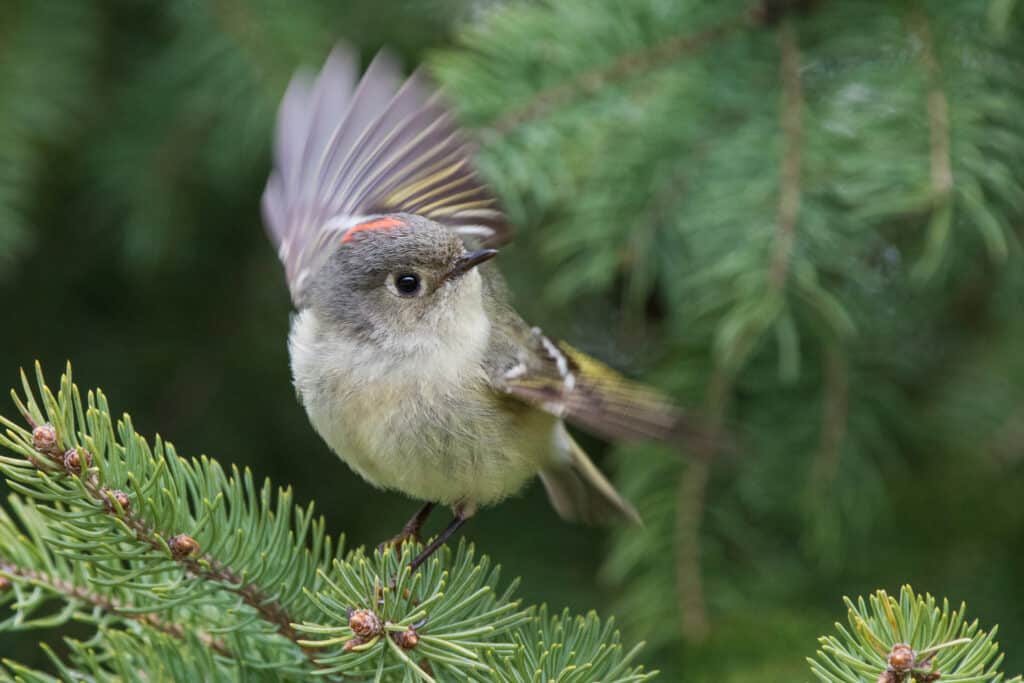
The wings of the
Ruby-Crowned Kinglet
seem to be in constant motion.
©Mircia Costina/Shutterstock.com
A minute, energetic bird, the ruby-crowned kinglet busily hops around tree branches and bushes, searching for small insects, spiders, and berries. They are native to North America, where they breed in Canada and winter in the southern United States and Mexico. And they nest in unique hanging cups inside coniferous forests, mountain shrubs, and floodplain forests. They sing loud, bubbly songs that are remarkably complex. And they often use their complicated notes to defend their territories. You can easily identify the ruby-crowned kinglet by the bright red crest on the male’s head. They also have teeny bills and large heads with basically no necks.
Cuban Tody
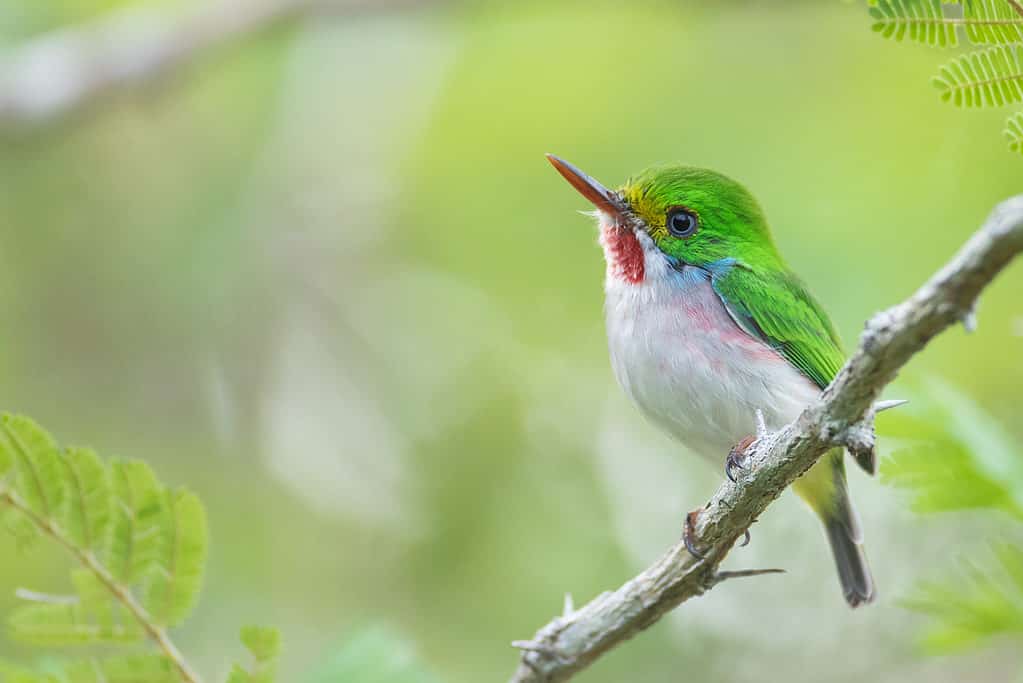
The Cuban tody is nonmigratory, living year-round in Cuba and the islands off its coast.
©Wirestock Creators/Shutterstock.com
Let’s continue the trend with tiny cute birds by introducing the Cuban tody. These colorful birds feature a small stature, measuring four inches long and weighing 0.2 ounces. They have large heads and thin, flat bills, and multicolored plumage. Their heads and backs are iridescent green, and their undersides are greyish-white. They also have red throats, pink flanks, and blue ear patches. You will often find this species in pairs singing their short, soft calls while sitting on a perch. The Cuban tody is nonmigratory, living year-round in Cuba and the islands off its coast. They are difficult to spot in their natural habitats as they live in dense underbrush. Their preferred habitats include evergreen forests, coastal vegetation, and dry lowlands.
Black-Capped Chickadee

Black-Capped Chickadees
live year-round in Canada, Alaska, and the northern United States.
©Steve Byland/Shutterstock.com
What’s a species universally recognized as one of the cutest birds in the world? The black-capped chickadee! With its oversized head and tiny round body, this species is a charming resident of North America. They live year-round in Canada, Alaska, and the northern United States. And you can find them in forests, open woodlands, parks, and thickets. If you want to identify this chickadee, look for its black cap, white cheeks, and streaked gray back.
Up Next:
- Meet the Cutest Owls in the World
- Cutest Bat: Which Bat Species is The Cutest in The World?
- The 10 Cutest Frogs in the World
- Discover the 10 Oldest Horse Breeds in the World
The photo featured at the top of this post is © Tiny Turkey/Shutterstock.com
Sources
- Cornell University, Available here: https://www.birds.cornell.edu/home/
- International Union for Conservation of Nature and Natural Resources, Available here: https://www.iucnredlist.org/
Thank you for reading! Have some feedback for us? Contact the AZ Animals editorial team.






